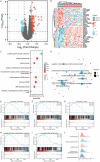Investigating possible dilated cardiomyopathy targets via bioinformatic analysis
- PMID: 37560246
- PMCID: PMC10408504
Investigating possible dilated cardiomyopathy targets via bioinformatic analysis
Abstract
Dilated cardiomyopathy (DCM) is the most common cardiomyopathy associated with heart failure; however, the underlying mechanism remains unclear. Initially, gene expression data of patients with DCM from the GSE4172 and GSE21610 datasets were obtained from the Gene Expression Omnibus website. Differentially expressed genes (DEGs) were analyzed with a false discovery rate < 0.05 and log2 fold change > 1.2. Furthermore, both the Kyoto Encyclopedia of Genes and Genomes (KEGG) analysis and Gene Set Enrichment Analysis (GSEA) were used to investigate the functional annotations. STRING and Cytoscape tools were used to form the protein-protein interaction (PPI) network and authenticate hub genes. Thereafter, the signature of immune-related genes (IRGs) was selected from the DEGs and data via the IMMPORT website. Hub genes were selected from the differentially expressed IRGs that formed the PPI network. Finally, the receiver-operating characteristic curves of the key genes were measured as biomarkers of DCM. A total of 173 independent DEGs (103 upregulated and 70 downregulated genes) were found in the microarray datasets GSE4172 and GSE21610. KEGG analysis and GSEA indicated that the BMP signaling pathway and apoptosis-related signals have a key effect on DCM development. The 10 hub genes also indicated the key effect of the BMP signaling pathway on DCM. A total of 224 differentially expressed IRGs and 20 featured IRGs were identified. Finally, BMP6, CD69, RUNX2, and SPP1 were identified as possible targets for DCM. Our data suggest a possible molecular regulatory mechanism for DCM therapy. Moreover, BMP6, CD69, RUNX2, and SPP1 may have key effects on the development of DCM.
Keywords: BMP6; CD69; Dilated cardiomyopathy; KEGG; RUNX2; SPP1; gene set enrichment analysis.
AJTR Copyright © 2023.
Conflict of interest statement
None.
Figures




Similar articles
-
Integrated microarray analysis to identify potential biomarkers and therapeutic targets in dilated cardiomyopathy.Mol Med Rep. 2020 Aug;22(2):915-925. doi: 10.3892/mmr.2020.11145. Epub 2020 May 14. Mol Med Rep. 2020. PMID: 32626989 Free PMC article.
-
Bioinformatics prediction of potential mechanisms and biomarkers underlying dilated cardiomyopathy.World J Cardiol. 2022 May 26;14(5):282-296. doi: 10.4330/wjc.v14.i5.282. World J Cardiol. 2022. PMID: 35702326 Free PMC article.
-
Alterated gene expression in dilated cardiomyopathy after left ventricular assist device support by bioinformatics analysis.Front Cardiovasc Med. 2023 Mar 17;10:1013057. doi: 10.3389/fcvm.2023.1013057. eCollection 2023. Front Cardiovasc Med. 2023. PMID: 37008310 Free PMC article.
-
Identification and Verification of Feature Biomarkers Associated With Immune Cells in Dilated Cardiomyopathy by Bioinformatics Analysis.Front Genet. 2022 May 12;13:874544. doi: 10.3389/fgene.2022.874544. eCollection 2022. Front Genet. 2022. PMID: 35646094 Free PMC article.
-
Common gene signatures and key pathways in hypopharyngeal and esophageal squamous cell carcinoma: Evidence from bioinformatic analysis.Medicine (Baltimore). 2020 Oct 16;99(42):e22434. doi: 10.1097/MD.0000000000022434. Medicine (Baltimore). 2020. PMID: 33080677 Free PMC article.
References
-
- Sammani A, Kayvanpour E, Bosman LP, Sedaghat-Hamedani F, Proctor T, Gi WT, Broezel A, Jensen K, Katus HA, Te Riele ASJM, Meder B, Asselbergs FW. Predicting sustained ventricular arrhythmias in dilated cardiomyopathy: a meta-analysis and systematic review. ESC Heart Fail. 2020;7:1430–1441. - PMC - PubMed
LinkOut - more resources
Full Text Sources
Research Materials
Miscellaneous
